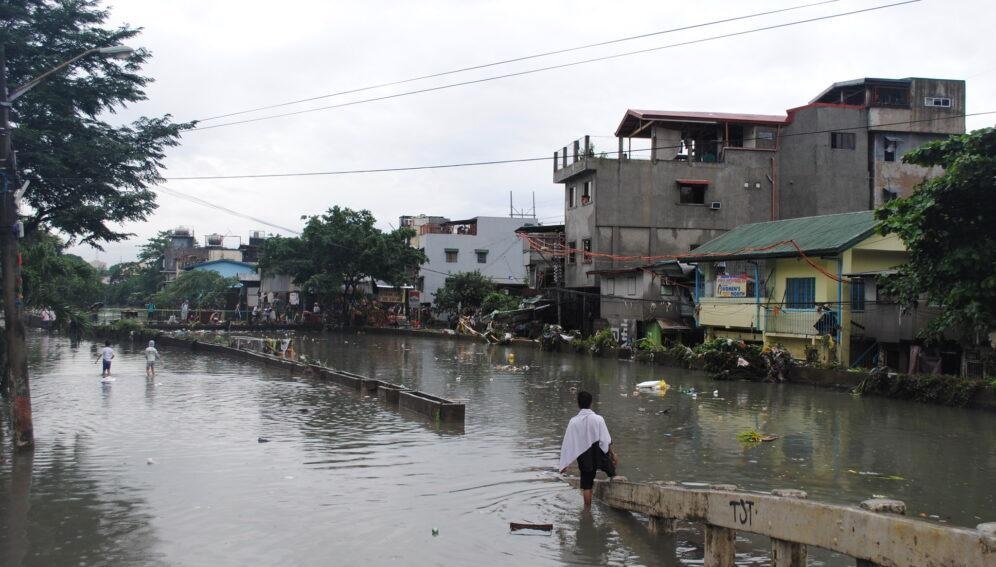Reviewed by Alex SmithApr 26 2022
According to a new study, Manila and various other coastal Asian cities are sinking faster compared to the rate of sea-level increase. This study urges for severe regulatory measures to help decrease groundwater extraction - a significant cause of land subsidence.
 Flooding in Manila in 2012. The capital of the Philippines is one of the cities in Asia rapidly sinking. Image Credit: AusAID (CC BY 2.0).
Flooding in Manila in 2012. The capital of the Philippines is one of the cities in Asia rapidly sinking. Image Credit: AusAID (CC BY 2.0).
As per the Intergovernmental Panel on Climate Change, since 1993, sea level increase has been taking place at a rate of nearly 3 mm per year.
But the Philippine capital observed land decreasing by more than 2 cm annually between 2015 and 2020. This is nearly seven times quicker compared to the average sea-level increase, thereby raising the likelihood of flooding.
The phenomenon of the land sinking quicker compared to sea level increase is more pronounced in Asian cities than elsewhere, states the study published in the journal Geophysical Research Letters.
Throughout the world, the study covered nearly 99 coastal cities, 33 of which have regions or parts that have subsided by over a centimeter per year. Scientists Pei-Chin Wu, Matt Wei and Steven D’Hondt from the Graduate School of Oceanography at the University of Rhode Island utilized satellite-based Interferometric Synthetic Aperture Radar to identify “fast-subsiding areas”.
The study stated surplus groundwater extraction is most probably the reason for the sinking of a few regions in these cities — probably impacting 59 million people. Expanding industries, rapid population growth and agricultural production, as well as a lack of water treatment and poor water quality of available surface water due to pollution, have all been identified as major reasons for increased reliance on groundwater in previous studies.
The study stated, “In most cities, part of the land is subsiding faster than sea level is rising. If subsidence continues at present rates, these cities will be challenged by flooding much sooner than projected by sea level rise models.”
The research also hinted, “The most rapid subsidence is occurring in South, South-East, and East Asia. However, rapid subsidence is also happening in North America, Europe, Africa, and Australia.”
Wei told SciDev.Net that land subsidence has reduced in Manila, even though unregulated groundwater extraction might invalidate any gains.
“According to one study, Manila had subsided at 3 cm per year from 2003 to 2010. So, our observation of 2 cm per year between 2015 and 2020 is slower,” stated Wei to SciDev.Net.
Wei along with his fellow researchers have stated that their findings denoted that subsidence rates in Indonesia, Jakarta and Shanghai, China “have slowed significantly likely due to reduced groundwater extraction rates implemented as government regulations.”
Between 1982 and 2010, land in Jakarta reduced by as much as 28 cm. In Shanghai, the land subsidence rate between 1990 and 2001 ranged from 1.6 cm annually. But from 2015 to 2020, subsidence fell and most significantly in Jakarta where it was 3 cm annually.
While opting for alternative sources of groundwater is considered an essential solution, Manila needs to alter how economic development is being tracked on the whole, stated Rodrigo Narod Eco, a researcher at the Marine Science Institute at the University of the Philippines.
I think the problem is fundamentally a development issue, where we have unabated conversion of landscapes and seascapes. For example, the subsiding areas in Manila City are mostly reclaimed land. Same as some other places too, like in Dagat-Dagatan, which was reclaimed during the Marcos dictatorship. Before that, it was a communal fishing ground.
Rodrigo Narod Eco, Researcher, Marine Science Institute, University of the Philippines
Rodrigo Narod Eco adds, “I think it can be possible to find alternative water sources, but we should still ask where the demand for water is coming from. Is it from commercial establishments, factories, plantations, fishponds? Even if we have alternative water sources, will it be available to households? Will the distribution be equitable?”
At the same time, the risk of land subsidence remains. Indonesia is being compelled to convert its capital to Nusantara from Jakarta where, as the study stresses, places like the Bekasi regency in the Indonesian capital are subsiding by 2 cm annually as a result of the groundwater extraction.
Semarang, the capital of Indonesia’s Central Java province, has observed land sinking by 3 cm annually as with Tianjin in China. This “dwarfed” the global mean sea level increase by nearly 15 times, stated the study.
Wei stated that the authorities in these coastal cities must come up with solutions that will fulfill both the issues of sea-level increase and land subsidence.
“The government should include coastal subsidence in their plan for sea-level rise,” stated Rodrigo Narod Eco.
Journal Reference:
Wu, P-C., et al. (2022) Subsidence in Coastal Cities Throughout the World Observed by InSAR. Geophysical Research Letters. doi.org/10.1029/2022GL098477.